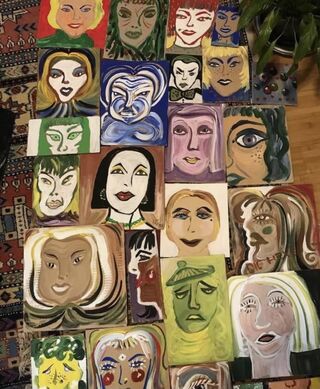Creativity
Creative Coping in Troubled Times
How can we enhance our resilience and give our battered coping skills a boost?
Posted August 22, 2021 Reviewed by Jessica Schrader
Key points
- Creative activities are one way to cope with stressful circumstances.
- Creative coping is associated with cognitive flexibility and increased well-being.
- Any challenges and engaging activity that leads to a sense of flow can be considered a creative coping activity.

The COVID-19 pandemic has forced us to experience more than 18 months of upheaval and isolation, a reality that has triggered fear and anxiety for our own and others' well-being. It is probable that stressors associated with ongoing stress, safety concerns, isolation, and quarantine can have a lasting negative impact on our physical and psychological well-being. One way of combating potentially negative outcomes is to build more effective coping mechanisms. Over the past year, I have had ongoing conversations with older men and women from diverse backgrounds. I have asked them how they have coped with their personal, familial, and social concerns during this difficult time. Although their recipes for coping vary, there were also surprising similarities in their responses: Nurture your creative spirit; discover creative activities that interest and challenge you; activities that can help you understand yourself and your world in new ways; activities that can help you forget about your concerns for a time.
Creative activities are one way of coping with stressful circumstances. They enable us to build resilience in difficult times. Creativity can be a central element of adult life, it is associated with engagement, originality, experimentation, and problem-solving. Creativity can be for everyone and can take many forms. When I ask people about creative coping, the answers are varied. People foster their creative spirit through painting, gardening, photography, meditation, walking, even daily meal preparation and cooking in new and novel ways. Any activity that brings a sense of joy, that helps us disengage from our concerns and worries for a time, can be helpful. Creative activities, however we define them, can help us manage our stressors and concerns more effectively.
Creative coping is particularly useful when attempting to cope with feelings of loneliness and isolation. Studies have found that nurturing creative impulses tend to lead to higher levels of life satisfaction and well-being. Humanistic psychologists such as Maslow (1962) focused on meaning, self-actualization, and individuation, concepts that play an important role in creativity. The notion of flow, a psychological state one experiences when fully engaged in an activity, is also associated with creativity (Csikszentmihalyi, 1975). Flow is an optimally satisfying experience in which creativity can be nurtured, a state of enjoyment in which one is fully engaged in the present.
Creativity has been associated with physical and psychological benefits (Schmidt, 2006). For example, creative engagement in adulthood promotes cognitive flexibility and results in new and novel ways of coping with life’s difficulties, particularly those connected to losses and adjustments of later life. During the past year, we have all had to cope with new and profound losses. The elders that I have spoken to fear that they may not have the time left to reconnect with people and activities they previously enjoyed. Pandemic isolation has reduced our social engagements and increased our disconnection and loneliness. Fear of contagion has reshaped many of our relationships. The stressors associated with the pandemic—social distancing, quarantine, loneliness, and fear of illness and premature death—have increased our vulnerability, anxiety, and depression (Schnell & Tahmaseb McConatha, 2021).
As we continue to struggle to maintain our well-being, finding novel ways of coping can be helpful in managing negative emotions and a sense of control over our lives. Fredrickson (2001) proposed the broaden-and-build theory of positive emotions. It is a theory that describes how emotions such as fear and anxiety can be reduced through engagement in emotionally rewarding activities. Nurturing our creativity is one way to build positive emotions and cope with negative ones. It is one way of increasing our resilience.
If creativity is understood broadly, every person is able to engage in creative activities that are emotionally rewarding. The restrictions of social distancing may have challenged our existing coping strategies. Activities such as group exercise, family gatherings, reliance on friendships, have been made more difficult (Bolwerk et al., 2014). Some researchers (Gonzalez et al., 2020) reviewed coping strategies used at an academic medical center and found that creative activities associated with art resulted in the ability to express emotions, prevent burnout, and build resilience during the pandemic.
Creativity is one way to build adaptive coping strategies and positive emotions that can help combat feelings of fragility and vulnerability. The words of wisdom shared by the elders I spoke with were not new, they were simple suggestions but still worth considering: Slow down, at least for a few minutes each day; reflect, meditate, walk—alone and with others; focus on how you feel and accept your feelings; challenge yourself; remember what gave you pleasure in the past, even in childhood, and build on those activities; reward yourself; read, write, spend time in nature; and nurture yourself.
References
Bolwerk, A., Mack-Andrick, J., Lang, F. R., Dörfler, A., & Maihöfner, C. (2014). How Art Changes Your Brain: Differential Effects of Visual Art Production and Cognitive Art
Evaluation on Functional Brain Connectivity. PLoS ONE, 9(7), 1–8. https://doi.org/10.1371/journal.pone.0101035
Csikszentmihalyi, Mihaly (1975). Beyond Boredom and Anxiety: Experiencing Flow in Work and Play, San Francisco: Jossey-Bass.
Fredrickson B. L. (2001). The role of positive emotions in positive psychology. The broadenand-build theory of positive emotions. The American psychologist, 56(3), 218–226.
https://doi.org/10.1037//0003-066x.56.3.218
Gonzalez, A., Cervoni, C., Lochner, M., Marangio, J., Stanley, C., & Marriott, S. (2020). Supporting health care workers during the COVID-19 pandemic: Mental health support initiatives and lessons learned from an academic medical center. Psychological Trauma :
Theory, Research, Practice and Policy, 12(S1), S168–S170 https://doi.org/10.1037/tra0000893
Maslow, A. H. (1962). Toward a psychology of being. Princeton: D. Van Nostrand Company.
Schnell, F. & Tahmaseb McConatha, J. (2021) Ageism and perceptions of vulnerability: Framing of age during the Covid-19 Pandemic. Advances in Social Science Research Journal, 8 (2) 170 – 177.
Schmidt, P. (2006). Creativity and Coping in Later Life. Generations: Journal of the American Society on Aging, 30(1), 27-31. doi:10.2307/26555439


